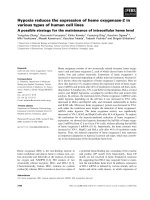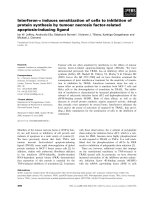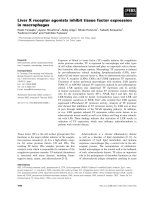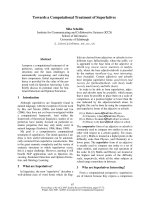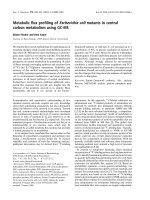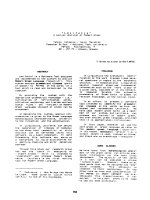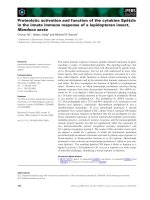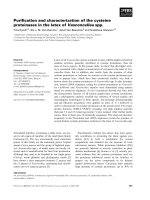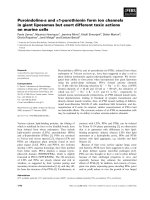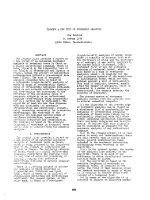Báo cáo khoa học: "PROVIDING A UNIFIED ACCOUNT OF DEFINITE NOUN PHRASES IN DISCOURSE" docx
Bạn đang xem bản rút gọn của tài liệu. Xem và tải ngay bản đầy đủ của tài liệu tại đây (592.78 KB, 7 trang )
PROVIDING A UNIFIED ACCOUNT OF
DEFINITE NOUN PHRASES IN DISCOURSE
Barbara J. Grosz
,M'tificial Intelligence Center
SRI International
Menlo Park. CA
Aravind K. Joshi
Dept. of Computer and Information Science
University of Pennsylvania
Philadelphia, PA
Scott Wcinstein
Dept. of Philosophy
University of Pennsylvania
Philadelphia, PA
1. Overview
Linguistic theories typically assign various linguistic
phenomena to one of the categories,
syntactic, semantic,
or
pragmatic, as
if the phenomena in each category were
relatively independent of those in the others. However,
various phenomena in discourse do not seem to yield
comfortably to any account that is strictly a syntactic or
semantic or pragmatic one. This paper focuses on
particular phenomena of this sort-the use of various
referring expressions such as definite noun phrases and
pronouns-and examines their interaction with
mechanisms used to maintain discourse coherence.
Even a casual survey of the literature on definite
descriptions and referring expressions reveals not only
defects in the individual accounts provided by theorists
(from several different disciplines), but also deep
confusions about the roles that syntactic, semantic, and
pragmatic factors play in accounting for these
phenomena. The research we have undertaken is an
attempt to sort out some of these confusions and to create
the basis for a theoretical framework that can account for
a variety of discourse phenomena in which all three
factors of language use interact. The major premise on
which our research depends is that the concepts necessary
for an adequate understanding of the phenomena in
question are not exclusively either syntactic or semantic
or pragmatic.
The next section of this paper defines two levels of
discourse coherence and describes their roles in accounting
for the use of singular definite noun phrases. To illustrate
the integration of factors in explaining the uses of
referring expressions, their use on one of these levels, i.e.,
the local one, is discussed in Sections 3 and 4. This
account requires introducing the notion of the centers of a
sentence in a discourse, a notion that cannot be defined in
terms of factors that are exclusively syntactic or semantic
or pragmatic. In Section 5, the interactions of the two
levels with these factors and their effects on the uses of
referring expressions in discourse are discussed.
2. The Effects of Different Levels of Discourse
Coherence
A discourse comprises utterances that combine into
subconstituents of the discourse, namely, units of
discourse that are typically larger than a single sentence,
but smaller than the complete discourse. However, the
constituent structure is not determined solely by the
linear sequence of utterances. It is common for two
contiguous utterances to be members of different
subconstituents of the discourse (as with breaks between
phrases in the syntactic analysis of a sentence); likewise, it
is common for two utterances that are not contiguous to
be members of the same subconstituent.
An individual subcoastituent of a discourse exhibits both
internal coherence and coherence with the other
subconstituents. That is, discourses have been shown to
have two levels of coherence.
Global coherence
refers to
the ways in which the larger segments of discourse relate
to one another. It depends on such things as the function
of a discourse, its subject matter, and rhetorical schema
[Grosz, 1977, 1981; Reichman, 1981 I.
Local coherence
refers to the ways in which individual sentences bind
together to form larger discourse segments. It depends on
such things as the syntactic structure of an utterance,
ellipsis, and the use of pronominal referring expressions
[Sidner, 1981 I.
The two levels of discourse coherence correspond to two
levels of
focusing global focusing
and
centering.
Participants are said to be globally focused on a set of
entitie.~ relevant to the overall discourse. These entities
may either have been explicitly introduced into the
discourse or be sufficiently closely related to such entities
to be considered implicitly in focus [Grosz, 19811 . In
contrast, centering refers to a more local focusing process,
one relates to identifying the single entity that an
individual utterance most centrally concerns [Sidner,
1979; Joshi and Weinstein, 1981].
IThis research was supported in part by the National
Science
Foundation under Grant MCS-8115105 to SRI International,
and
Grant MCS81-07290 to the University of Pennsylvania.
44
The two
levels
of focusing/coherence have different
effects on the processing of pronominal
and
nonpronominal definite noun phrases. Global coherence
and focusing are major factors in the generation
and
interpretation of nonpronominal def'lnite referring
expressions. 2 Local coherence and centering have greater
effect on the processing of pronominal expressions. In
Section 5 we shall describe the rules governing the use of
these kinds of expressions and shall explain why
additional processing by the hearer (needed for drawing
additional inferences} is involved when pronominal
expressions are used to refer to globally focused entities or
nonpronominal expressions are used to refer to
centered
entities.
Many approaches to language interpretation have
ignored these differences, depending instead on powerful
inference mechanisms to identify the referents of referring
expressions. Although such approaches may suffice,
especially for well-formed texts, they are insufficient in
general. In particular, such approaches will not work
for
generation. Here the relationships among focusing,
coherence, and referring expressions are essential
and
must be explicitly provided for. Theories-and systems
based on them will generate unacceptable uses of
referring expressions if they do not take these
relationships into account. 3
3. Centering and Anaphora
In our theory, the centers of a sentence in a discourse
serve to integrate that sentence into the discourse. Each
sentence, S, has a single
backward-looking center,
Cb(S),
and a set of
forward-looking centers,
Cf(S). Cb(S) serves
to link S to the preceding discourse, while Cf(S) provides
a set of entities to which the succeeding discourse may be
linked. To avoid confusion, the phrase =the center" will
be used to refer only to Cb(S).
To clarify the notion of center, we will consider a
number of discourses illustrating the various factors that
are combined in its definition (abstractly) and in its
identification in a discourse. In Section 5 we define center
more precisely, show how it relates to Sidner's [1981]
immediate focus and potential loci, and discuss how the
linkages established by the centers of a sentence help to
determine the degree of intelligibility of a discourse. We
begin by showing that the center cannot be defined in
syntactic terms alone. The interaction of semantics and
centering is more complex and is discussed in Section 4.
The following examples, drawn from Reinhart [1982],
illustrate the point that the notion of center is not
syntactically definable, 4 i.e., the syntax of a sentence S
does not determine which of its NPs
realizes
Cb(S). (The
2They differ in other respects also. Reichman [19811
a~d Grosz
[19811 discuss
some
of these.
3Initial attempts
to incorporate
focusing mechanisms in
generation
systems are described in [Appelt, 1981 and MeKeown, 1982].
41ntonation can obviously affect
the interpretation; for
the
purposes of this paper, it may be regarded a~ part of a syntax.
reasons for the use of this terminology axe discussed in
Section 4.)
(t&) Who did Max see yesterday?
(lb) Max saw Rosa.
(2a) Did anyone see Ros& yesterday?
(2b)
Max
s~w Rosa.
Although (lb) and (2b) are identical, Cb(lb) is Max and
Cb(2b) is Rosa. This can be seen in part by noticing that
=He saw Rosa" seems more natural than (lb) and =Max
saw her" than (2b) (a fact consistent with the centering
rule introduced in Section 5.) The subject NP is the
center in one context, the object NP in the other.
Even when the NP used to realize Cb(S) can be
syntactically determined, the Cb(S) itself is not yet fully
determined, for Cb(S) is typically not a linguistic entity
(i.e., it is not a particular linguistic expression). Rosa, not
°Rosa ° is the Cb(2b). Consider. the discourse:
(3z) How is Rosa?
(3b) Did anyone see her yesterday?
(3e) Max saw her.
Here, Cb(3c) is Rosa, but clearly would not be in other
contexts where the expression "her" still realized the
backward-looking center of "Max saw her." This is seen
most simply by considering the discourse that would
result if "How is Joan?" replaced (3a). In the discourse
that resulted, Joan, not Rosa, would be the center of (3c).
4.
Centering and Realization
The interactions of semantic and pragmatic factors with
centering and their effects on referring expressions are
more complex than the preceding discussion suggests. In
the examples given above, the NPs that realize Cb(S) also
denote it., but this is not always the case: we used the
term "realize" in the above discussion advisedly. In this
section, we consider two kinds of examples in which the
center of a sentence is not simply the denotation of some
noun phrase occurring in the sentence. First, we will
examine several examples in which the choice of and
interaction among different kinds of interpretations of
definite noun phrases are affected by the local discourse
context (i.e., centering}. Second, the role of pragmatic
factors in some problematic cases of referential uses of
definite descriptions [Donnellan 1966] is discussed.
4.1. Realization and Value-Free
and Value-Loaded
Interpretations
The distinction between
realization
and semantic
denotation is necessary to treat the interaction between
value-free and value-loaded interpretations [Barwise and
Perry, 1982] of definite descriptions, as they occur in
extended discourse. Consider, for example, the following
sequence:
45
(4a) The vice
president of the
United States
is also president of the Senate.
(4b) Historically, he is the president's key
man in negotiations with Congress.
(4b') As Ambassador to China, he handled
many tricky negotiations, so he is
well prepared for this Job.
Cb(4b) and Cb(4b') are each realized by the anaphoric
element "he. = But (4b) expresses the same thing as
"Historically, the vice president of the United States is
the president's key man in negotiations with Congress"
(in which it is clear that no single individual vice
president is being referred to) whereas (4b') expresses the
same thing as, "As ambassador to China, the [person who
is now] vice president of the United States handled many
tricky negotiations, " This can be accounted for by
observing that "the vice president of the United States"
contributes both its value-free interpretation and its
value-loading at the world type to Cf(4a). Cb(4b) is then
the value-free interpretation and Cb(4b') is the value-
loading, i.e., George Bush.
In this example, both value-free and value-loaded
interpretations are showu to stem from the same full
definite noun phrase. It is also possible for the movement
of the center from a value-free interpretation (for Cb(S))
to a value-loaded interpretation (for Cb of the next
sentence)-or vice versa-to be accomplished solely with
pronouns. That is, although (4b)-(4b') is (at least for
some readers) not a natural dialogue, similar sequences
are possible.
There appear to be strong constraints on the kinds of
transitions that are allowed. In particular, if a given
sentence forces either the value-free or value-loaded
interpretation, then only that interpretation becomes
possible in a subsequent sentence. However, if some
sentence in a given context merely prefers one
interpretation while allowing the other, then either one is
possible in a subsequent sentence.
For example, the sequence.
(Sa)
The
vice
president of the
United States
is
also president of the
Senate.
(Sb) He's the president's key a~ in ne~otiatione
with
Congress.
in which "he" may be interpreted a~ either value-free
(iT') or value-loaded (VL}, may be followed by either of
the following two sentences:
(5c)
As ambassador
to China.
he
handled many tricky negotiations.
(VL)
(5c') He is required to he
at
least 35 years old. (V'F')
tlowever, if we change (Sb) to force the value-loaded
interpretation, as in (5b'), then only (5c) is possible.
($b')
Right non he is the president's
key man £n negotiations sith Congress.
Similarly, if {5b) is changed to force the value-free
interpretation, as in {4b), then only (5c') is possible.
If an intermediate sentence allows both interpretations
but prefers one in a given context, then either is possible
in the third sentence. A use with preference for a value-
loaded interpretation followed by a use indicating the
value-free interpretation is illustrated in the sequence:
John thinks that
the telephone
£s a toy.
He plays with it
every day. (V~ preferred;
V~ok)
He doesn't realize that £t is tn
£nventlon
that
changed the
world. (V~
The preference for a value-free interpretation that is
followed bv a value-loaded one is easiest to see in a
dialogue situation:
st: The vice president of the United States
is also president of the Senate.
s2: I thought he played some
important role in the House. (VFpreferred; VL ok)
st: He did. but that van before he vu VP. (V~)
4.2. Realization and Referential Use
From these examples, it might appear that the concepts
of value-free and value-loaded interpretation are identical
to Donnellan's I19661 attributive and referential uses of
noun phrases. However, there is an important difference
between these two distinctions. The importance to our
theory is that the referential use of definite noun phrases
introduces the need to take pragmatic factors (in
particular speaker intention) into account, not just
seman| ic factors.
DonnelIan [1966[ describes the referential and
attributive uses of definite descriptions in the following
way:
"A speaker who uses a definite description
attributively in an assertion states something
about whoever or whatever is the so-and-so. A
speaker who uses a definite description
referentially in an a~sertion, on the other hand ,
uses the description to enable his audience to
pick out whom or what he is talking about and
states something about that person or thing. In
the first case the definite description might be
said to occur essentially, for the speaker wishes
to assert something about whatever or whoever
fits that description; but in the referential use
the definite description is merely one tool for
doing a certain job calling attention to a person
or thing and in gefieral any other device for
doing the same job, another description or a
name. would do as well. In the attributive use,
the attribute of being the so-and-so is all
imp~,rtant, while it is not in the referential use.*
The distinction Donnellan suggests can be formulated in
terms of the different propositions a sentence S containing
a definite description D may be used to express on
differcn! occasions of use. When D is used referentially, it
contributes its denotation to the proposition expressed by
~6
S; when it is used attributively, it contributes to the
proposition expressed by S a semantic interpretation
related to the descriptive content of D. The identity of
this semantic interpretation is not something about which
Donnellan is explicit. Distinct formal treatments of the
semantics of definite descriptions in natural language
would construe the appropriate interpretation differently.
In semantic treatments based on possible worlds, the
appropriate interpretation would be a (partial} function
from possible worlds to objects; in the situation semantics
expounded by Barwise and Perry, the appropriate
interpretation is a (partial} function from resource
situations 5 to objects.
.As just described, the referential-attributive distinction
appears to be exactly the distinction that Barwise
and
Perry formulate in terms of the value-loaded and value-
free interpretations of definite noun phrases. But this
gloss omits an essential aspect of the referential-
attributive distinction as elaborated by Donnellan. In
Donnellan's view, a speaker may use a description
referentially to refer to an object distinct from the
semantic denotation of the description, and, moreover, to
refer to an object even when the description has no
semantic denotation.
In one sense, this phenomenon arises within the
framework of Barwise and Perry's treatment of
descriptions. If we understand the semantic denotation of
a description to be the unique object that satisfies the
content of the description, if there is one, then Barwise
and Perry would allow that there are referential uses of a
description D that contribute objects other than the
semantic denotation of D to the propositions expressed by
uses of sentences in which D occurs. But this is only
because Barwise and Perry allow that a description may
be evaluated at ~ resource situation other than the
complete situation in order to arrive at its denotation on
a given occasion of use. Still, the denotation of the
description relative to a given resource situation is the
unique object in the situation that satisfies the description
relative to that situation.
The referential uses of descriptions that Donnellan gives
examples of do not seem to arise by evaluation of
descriptions at alternative resource situations, but rather
through the "referential intentions" of the speaker in his
use of the description. This aspect of referential use is a
pragmatic rather than a semantic phenomenon and is best
analyzed in terms of the distinction between semantic
reference and speaker's reference elaborated in Kripke
[10vv].
Con~idcr the following discourses drawn from Kripke
{lov~'l:
(6a) Her husband is kind to her.
(6b) No. he isn't. The
usa
you're
referring to
isn't
her husband.
(7a) Her husband is kind to her.
(7b) He is kind to her but be isn't her husband.
With (6a) and (7a), Kripke has in mind a case like the
one discussed in Donnellan [1066], in which a speaker uses
a description to refer to something other than the
semantic referent of that description, i.e., the unique thing
that satisfies the description (if there is one). Kripke
analyzes this case as an instance of the general
phenomenon of a clash of intentions in language use. In
the case at hand, the speaker has a general intention to
use the description to refer to its semantic referent; his
specific intention, distinct from his general semantic
intention, is to use it to refer to a particular individual.
He incorrectly believes that these two intentions coincide
and this gives rise to a use of the referring expression "her
husband" in which the speaker's reference and the
semantic reference are distinct. "8 (The speaker's referent
is presumably the woman's ]over).
From our point of view, the importance of the case
resides in its showing that Cf(S) may include more than
one entity, that is realized by a single NP in S. In this
case, "her husband" contributes both the husband and
the lover to Cf{6a} and Cf(Ta). This can be seen by
observing that both discourses seem equally appropriate
and that the backward-looking centers of (6b) and /7b)
are the husband and the lover, respectively, realized by
their anaphoric elements. Hence, the forward-looking
centers of a sentence may be related not semantically but
pragmatically to the NPs that realize them.
Hence, the importance of the referential/attributive
distinction from our point of view is that it leads to cases
in which the centers of a sentence may be pragmatically
rather than semantically related to the noun phrases that
realize them.
5. Center Movement and Center
Realization
Constraints
In the foregoing sections we have discussed a number of
examples to illustrate two essential points. First, the noun
phrase that realizes the backward-looking center of an
utterance in a discourse cannot be determined from the
syntax of the utterance alone. Second, the relation N
realizes c
between noun phrases N and centers c is
neither solely a semantic nor solely a pragmatic relation.
This discussion has proceeded at a rather intuitive level,
without explicit elaboration of the framework we regard
as appropriate for dealing with centering and its role in
explaining disco,trse phenomena. Before going on to
describe constraints on the realization relation that
5Roughly, *any situation on which
the speaker can
focus
attention ° is a potential candidate
for a resource
situation with
respect to which the
speaker may value load his
uses
of
definite
descriptions. Such resource situations must contain a unique object
which satisfies the description.
6There are, of
course, several alternative explanations; e.g., the
speaker may believe that the description is more likely than an
accurate one to be interpreted correctly by the hearer. Ferreting out
exactly what the case is in a given situation requires accounts of
mutual belief and the like. A discussion of these issues is beyond the
scope of this
paper.
h7
explain certain phenomena in discourse, we should be
somewhat more explicit about the notions of center and
realization.
We have said that each utterance S in a discourse has
associated with it a backward-looking center, Cb(S), and
a set of forward-looking centers, Cf(S). What manner of
objects are these centers? They are the sort of objects
that can serve as the semantic interpretations of singular
noun phrases. 7 That is, either they are objects in the
world (e.g., planets, people, numbers} or they are
functions from possible worlds (situations, etc.} to objects
in the world that can be used to interpret definite
descriptions. That is, whatever serves to interpret a
definite noun phrase can be a center.
For the sake of concreteness in many of the examples in
the preceding discussion, we have relied on the situation
semantics of Barwise and Perry. The theory we are
developing does not depend on this particular semantical
treatment of definite noun phrases, but it does require
several of the distinctions that treatment provides. In
particular, our theory requires a semantical treatment
that accommodates the distinction between
interpretations of definite noun phrases that contribute
their content to the propositions expressed by sentences in
which they occur and interpretations that contribute only
their denotation-in other words, the distinction between
value-free and value-loaded interpretations. As noted, a
distinction of this sort can be effected within the
framework of "possible-worlds" approaches to the
semantics of natural language. In addition, we see the
need for interpretations of definite noun phrases to be
dependent on their discourse context. Once again, this is a
feature of interpretations that is accommodated in the
relational approach to semantics advocated by Barwise
and Perry, but it might be accommodated within other
approaches as well. 8
Given that Cb(S), the center of sentence S in a
discourse, is the interpretation of a definite noun phrase,
how does it become related to S? In a typical example, S
will contain a full definite noun phrase or pronoun that
realizes the center. The realization relation is neither
semantic nor pragmatic. For example, N realizes c may
hold in cages where N is a definite description and c is its
denotation, its value-free interpretation, or an object
related to it by a "speaker's reference." More
importantly, when N is a pronoun, the principles that
govern which c are such that N realizes c derive from
neither semantics nor pragmatics exclusively. They are
principles that must be elicited from the study of
discourse itself. A tentative formulation of some such
principles is given below.
Though it is typical that, when c is a center of S, S
contains an N such that N realizes c, it is by no means
necessary. In particular, for sentences containing noun
7In a fuller treatment of our theory we will consider centers
that
are realized by constituents in
other syntactic categories.
81srael [1983] discusses some of these issues
and compares
several
properties of situation semantics with Montague semantics.
phrases that express functional relations (e.g., "the door,"
• the owner'} whose arguments are not exhibited
explicitly (e.g., a house is the current center, but so far
neither its door nor its owner has been mentioned), 9 it is
sometimes the case that such an argument can be the
backward-looking center of the sentence. We are
currently studying such cases and expect to integrate that
study into our theory of discourse phenomena.
The basic rule that constrains the realization of the
backward-looking center of an utterance is a constraint on
the speaker, namely:
[f the Cb of the current utterance is the same as the
Cb of the previous utterance, a pronoun should be used.
There are two things to note about this rule. First, it
does not preclude using pronouns for other entities as long
as one is used for the center. Second, it is not a hard
rule, but rather a principle, like a Gricean maxim, that
can be violated. However, such violations lead at best to
conditions in which the hearer is forced to draw
additional inferences.
As a simple example, consider the following sequence,
assuming at the outset that John is the center of the
discourse:
(Sa) He called up Mike yesterday. (he=John)
(Sb) He ,as annoyed by John's call.
(8b) is unacceptable, unless it is possible to consider the
introduction of a second person named "John." However,
intervening sentences that provide for a shift in center
from John to Mike (e.g., "He was studying for his driver's
test') suffice to make (8b) completely acceptable.
Sidner's
discourse focus
corresponds roughly to Cb(S),
while her
potential foci
correspond approximately to
Cf(S). However, she also introduces an
actor focus
to
handle multiple pronouns in a single utterance. The basic
centering rule not only aLlows us to handle the same
examples more simply, but also appears to avoid one of
the complications in Sidner's account. Example D4 from
Sidner [1081} illustrates this problem:
(9-1)I haven't seen Jeff for several
days,
(9-2)Carl thinks he's studying for his exams.
(9-3)But
I
think he Tent bo the Cape with Llnda.
On Sidner's account, Carl is the actor focus after (0-2)
and Jeff is the discourse focus (Cb(9-2)). Because the actor
focus is preferred as the referrent of pronominal
expressions, Carl is the leading candidate for the entity
referred to by
he
in {9-3}. It is difficult to rule this case
out without invoking fairly special rules. On our account,
Jeff is Cb(0-2) and there is no problem. The addition of
actor focus was made to handle multiple pronouns for
example, if (9-3) were replaced by
He thinks he studies too much.
The center rule allows such uses, without introducing a
9Grosz [1977] refers to this a~ "implicit focusing'; other examples
are presented in Joshi and Weinstein [1981]
~,8
second kind of focus (or center), by permitting entities
other than Cb(S) to be pronominalized as long as Cb(S)
is.l°
Two aspects of centering affect the kinds of inferences a
hearer must draw in interpreting a definite description.
First, the shifting of center from one entity to another
requires recognition of this change. Most often such
changes are affected by the use of full definite noun
phrases, but in some instances a pronoun may be used.
For example, Grosz [1977] presents several examples of
pronouns being used to refer to objects mentioned many
utterances back. Second, the hearer must process
(interpret) the particular linguistic expression that realizes
the center.
Most previous attempts to account for the interaction of
different kinds of referring expressions with centering and
focusing (or "topic') have conflated these two. For
example, Joshi and Weinstein
[1981]
present a preliminary
report on their research regarding the connection between
the computational complexity of the inferences required
to process a discourse and the coherence of that discourse
as assessed by measures that invoke the centering
phenomenon. However, several of the examples combine
changes of expression and shifts in centering.
Violations of the basic centering rule require the hearer
to draw two different kinds of inferences. The kind
required depends on whether a full definite noun phrase is
used to express the center or whether a pronoun is used
for a noncentered entity. We will consider each case
separately.
Several different functions may be served by the use of
a full definite noun phrase to realize the currently
centered entity. For instance, the full noun phrase may
include some new and unshared information about the
entity. In such cases, additional inferences arise from the
need to determine that the center has not shifted and that
the properties expressed hold for the centered entity. For
example, in the following sequences
(I0) I toole i 7
clog to
the
vet
the
other
day.
The mangy old beast
(11) I'm reading The French Lieutenant's
Woman.
The book, which In
Fowles best
the full definite noun phrases that are in boldface do
more than merely refer.
When the current center is not pronominalized (it may
not be present in the sentence), the use of a pronoun to
express an entity other than the current center, is
strongly constrained. The particular cases that have been
identified involve instances in which attention is being
shifted back to a previously centered entity (e.g., Grosz,
1977; Reichman, 1978) or to one element of a set that is
currently centered. In such cases, additional inferences
10Obviously, if Cb(S) is not expressed'in the next sentence then
this issue does not arise.
are required to determine that the pronoun does not refer
to the current center, as well as to identify the context
back to which attention is shifting. These shifts, though
indicated by linguistic expressions typically used for
centering (pronouns), correspond to a shift in global focus.
8.
Summary
The main purpose of the paper was to sort out the
confusion about the roles of syntactic, semantic, and
pragmatic factors in the interpretation and generation of
definite noun phrases in discourse. Specific mechanisms
that account for the interactions among these factors were
presented. Discourses were shown to be coherent at two
different levels, i.e., with referring expressions used to
identify entities that are centered locally and those
focused upon more globally. The differences between
references at the global and local levels were discussed,
and the interaction of the syntactic role of a given noun
phrase and its semantic interpretation with centering was
described.
References
Appelt, D.E., "Planning Natural-Language Utterances, °
Proc. of the National Conference on Artificial
Intelligence,
Pittsburgh, Pennsylvania (August 1982).
Barwise, J. and Perry, J.
Situations and Attiludes,
Bradford Books, Cambridge, Mass. (1982)
Donnellan, K., "Reference and Definite Description,"
Philosophical Review,
Vol. 60, pp. 281-304 (1966).
Grosz, B.J., "The Representation and Use of Focus in
Dialogue Understanding," Ph.D. Thesis, University of
California, Berkeley. Also, Technical Note No. 151,
Artificial Intelligence Center, SRI International. (1977).
Grosz, B.J., "Focusing and Description
Language Dialogues,"
Elements of
Understanding,
Joshi et al., (eds.) Cambridge
Press, Cambridge, England (1982).
in Natural
Discourse
University
Israel, D.J., "A Prolegomenon to Situation Semantics,"
Proc. of the 21st Annual Meeting of the Assoc. for
Computational Linguistics,
Cambridge, Mass. (June
15-17, 1983).
Joshi, A. and S. Weinstein, "Control of Inference: Role
of Some Aspects of Discourse Structure-Centering,"
Proc. bzternational Joint Conference on Artificial
Intelligence,
Vancouver, B.C. pp. 385-387 {August 24-28,
I08t).
Kripke, S., "Speaker's Reference and Semantic
Reference,"
Contemporary Pespectives in the Philosophy
of Language,
University of Minnesota Press, Minneapolis,
Minnesota, pp. 6-27, (1977).
McKeown, K.R., "The TEXT System for Natural
Language Generation: An Overview,"
Proc. of the 20th
.4nnual Aieeting of the Assoc. for Computational
Linguistics,
16-18 June 1982, Toronto, Ontario, Canada
(June 1982}.
/49
Reichman, R. "Conversational Coherency," Cognitive
Science Vol. 2, No. 4, pp. 283-327, (1978}.
Reichman, R. "Plain Speaking: A Theory and Grammar
of Spontaneous Discourse," Technical Report No. 4681,
Bolt Beranek and Newman, Cambridge, Mass. (June
1981).
Reinhart, T., "Prag'maties and Linguistics, An Analysis
of Sentence Topics," Indiana University Linguistics Club,
Bloomington, Indiana (1978).
Sidner, C.L., Toward a Computational Theory of
Definite Anaphora Comprehension in English, MIT
Technical Report AI-TR-537, (1979).
Sidner, C., "Focusing for Interpretation of Pronouns,"
American Journal of Computational Linguistics Vol. 7,
No. 4, pp. 217-231 (1981).
5O
